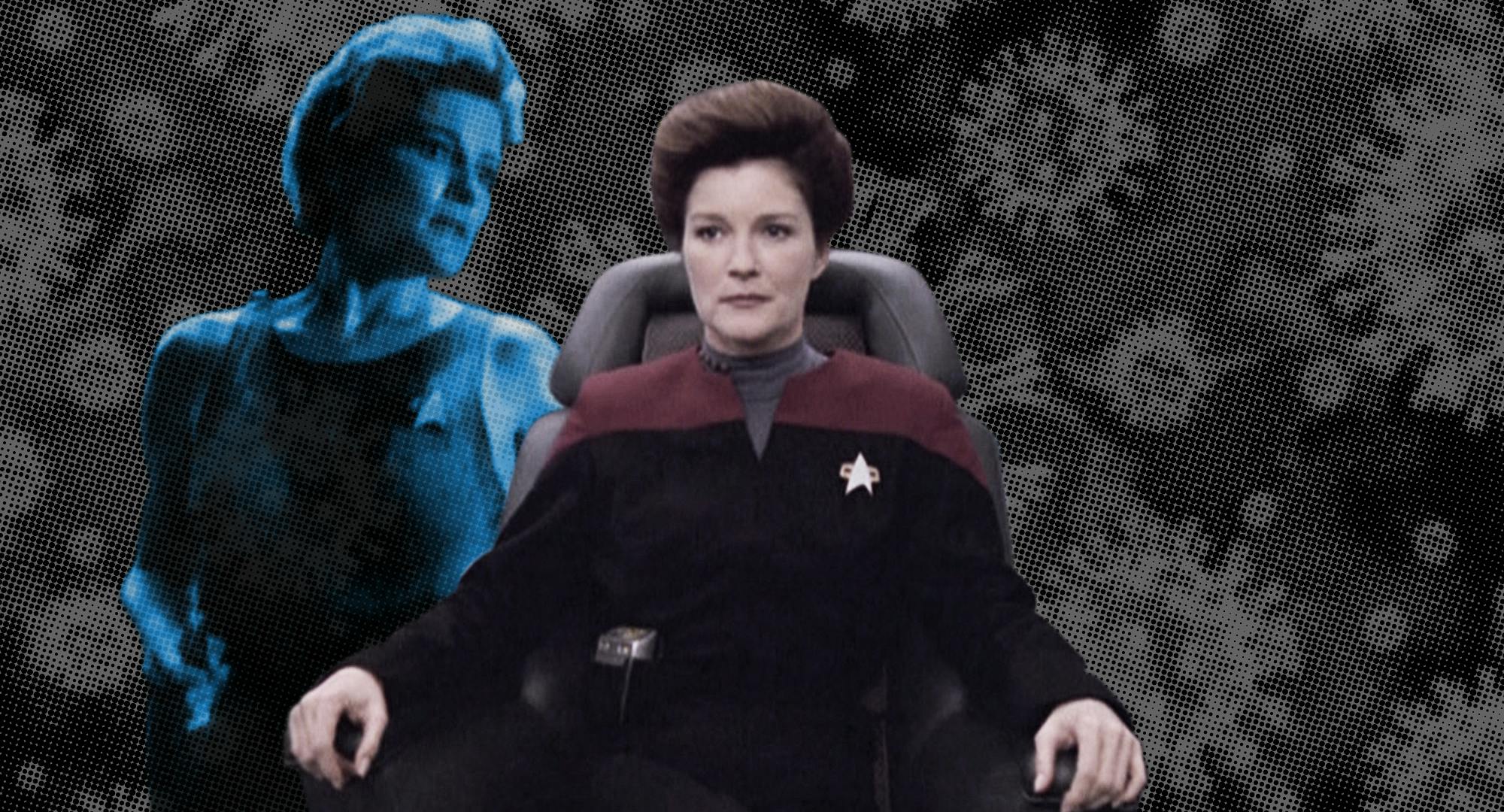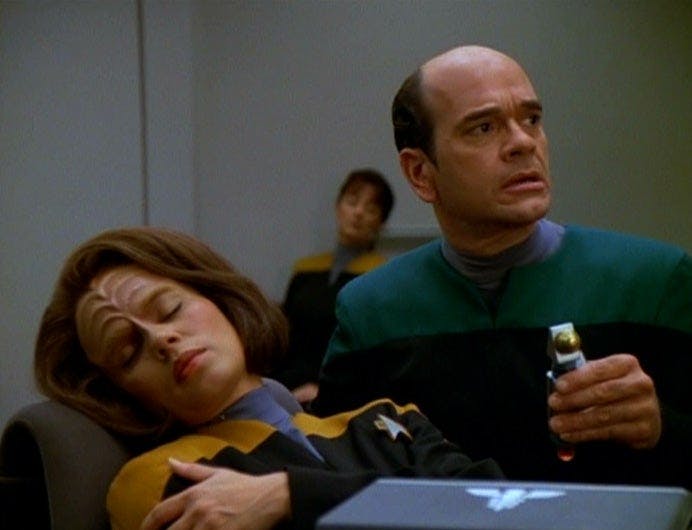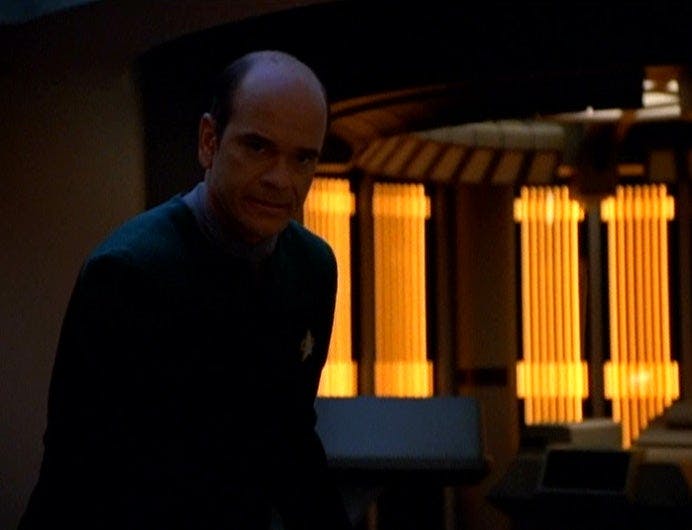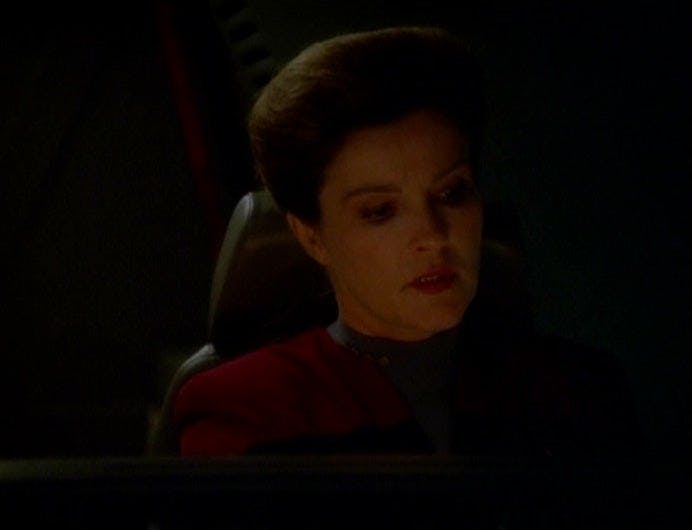Published Mar 18, 2020
Voyager’s Macrocosm is a Covid-19 Cautionary Tale
And right now, it's just what we need.

StarTrek.com
Science fiction is often a vehicle for what might be, and many shows play with the idea of an illness outbreak sometime during their run. Star Trek: Voyager is no exception. While they played with the idea of a virus and isolation in the season two episode “Resolutions,” their second foray into the genre is an entirely different animal.
Season three’s “Macrocosm,” is a cautionary tale that fits perfectly into COVID-19 and social distancing. Fans may remember it as the episode featuring giant viruses that had Janeway walking around in her tank top being a commando badass. Who could forget the knife vs. tentacle fight? However, peel back the layers, and the narrative behind those events has, regretfully, aged well in the time of coronavirus.
Let’s start by looking at the point of infection. The virus gets on board Voyager because the Doctor is eager to try out his new mobile emitter and wants to do what physicians do: help people who are sick. Janeway and Neelix are on an away mission with the Tak Tak, and that leaves Chakotay in charge of Voyager, who allows the Doctor to go down to the planet’s surface and aid a group of ill miners. The Doctor says that since he’s a hologram he won’t get sick and there is minimal risk to the crew.

StarTrek.com
A statement that proves to be very, very wrong.
When the Doctor is transported back up, the organisms are transported along with him. They move so quickly that it only takes a few seconds for the viruses to migrate to the transporter buffer. From there it infects the bio-neural gel-packs of the ship and eventually the crew. If we need to hold up an episode to make the case for social distancing this is the one. The crew’s directive to seek out new life and new civilizations (while also trying to get home) is all well and good, but had they not sent the Doctor the virus wouldn’t have gotten onto Voyager. It was the Doctor’s hubris in thinking he was immune that ultimately endangered the ship.
Fortunately, Voyager is a closed system, so as long as crewmembers didn’t leave the ship the virus couldn’t spread throughtout the galaxy. However, that doesn’t stop the virus from making its way amongst the crew. That’s when you remember the Tak Tak, who show up at the worst possible moment. Their answer to stopping the spread is, “Kill them all!” because there is no cure for the virus. Suddenly, the Tak Tak’s top of the episode send-off, “Good health, strong body, clear mind,” starts to make sense when you realize these guys probably knew this was going around the Delta Quadrant. How much did you want to bet that didn’t come up in the trade negotiations when they talked about the sector?

StarTrek.com
This episode is not saying, burn down your neighbor’s house if they’re infected with COVID-19. (Seriously, do not do that; that’s arson!) It’s also not asking that you distrust neighbors to the point of fisticuffs and toiletpaper heists! Rather, stay inside, limit your movement, and avoid getting infected so that professionals have the time to develop a treatment, while not overwhelming our already fragile healthcare system.. Think about what would have happened if the Tak Tak had continued their destruction. Not only would the cure not have been deployed to Voyager, but it also wouldn’t have been shared with the Tak Tak, and likely other worlds affected in that sector. When the Tak Tak stopped their attack, they let Voyager help them solve a problem. It’s an extreme and very compact example, but it still works; and given the difficulty we’re having getting some sectors of the public to take social distancing seriously, perhaps an extreme example is needed.
Of course, in the case of COVID-19, we need to work for more than the length of an hourlong episode in order to flatten the curve of spread. Many schools are closed down, and more people are self-isolating and working from home. We are all essentially waiting for something that cannot see to pass, and since the world is bigger than a starship, it’s going to take longer to run its course.
Like the disease of ‘Macrocosm,” part of what makes COVID-19 scary is that we can’t see it, we don’t know anything about it, and the only sign we really have that it’s near is when someone is symptomatic. Microscopic organisms don’t always lend themselves well to decisive action either, but moving this virus into the macroscopic world gives Janeway, and the crew, something physical to fight against.

StarTrek.com
It also makes detection more readily available. As “Macrocosm” progresses, both Janeway and Neelix are infected by the virus’s tentacles. When Janeway is attacked on the bridge there’s no question that she’s come in contact with something that could prove deadly, and she goes to sickbay. Knowing she’s infected gives Janeway an edge in seeking treatment; the doctor is able to test his antigen and together, they can save the entire crew. In the end, this is a fictional universe, and “Macrocosm” isn’t a perfect real-world example, but the story is a solid one when it comes to living in a global pandemic. Ultimately, the thing to take away from “Macrocosm” this week is that ultimately, Voyager went back to normal. They deployed the antigen, the crew recovered, and they continued on their way home in “good health.” So long as we all take meaningful, direct steps to help prevent the spread of Covid-19, our world can and will do the same.
Lauren Busser (she/her) is a writer living in Connecticut and the Associate Editor at Tell-Tale TV. She is fascinated by the way humans interact with technology. You can find her on Twitter @LaurenBusser

